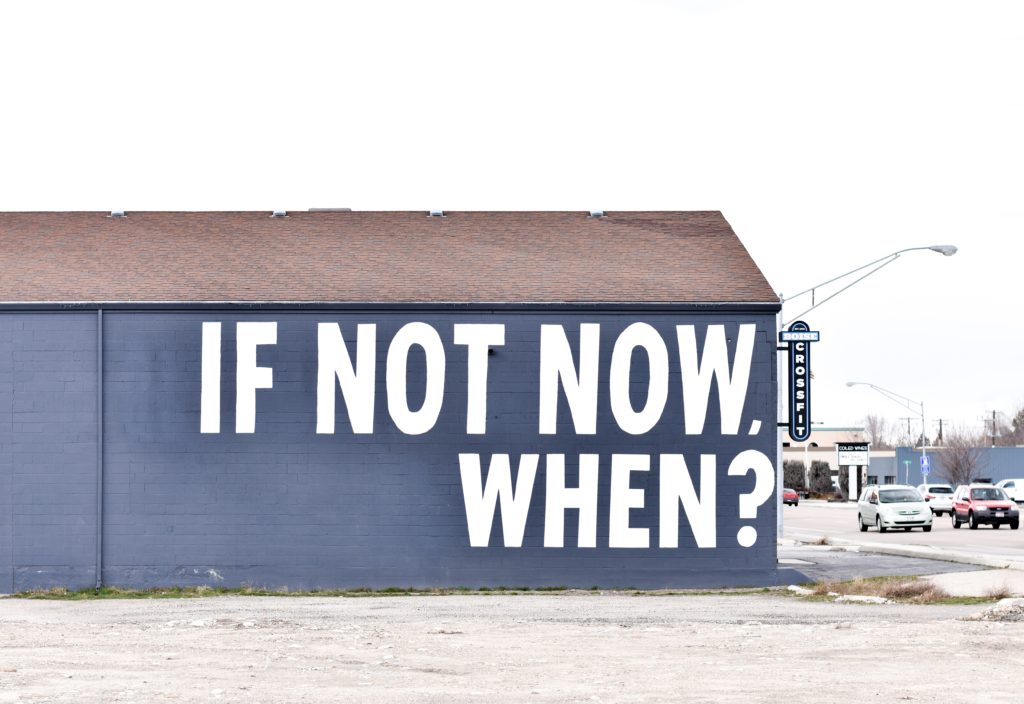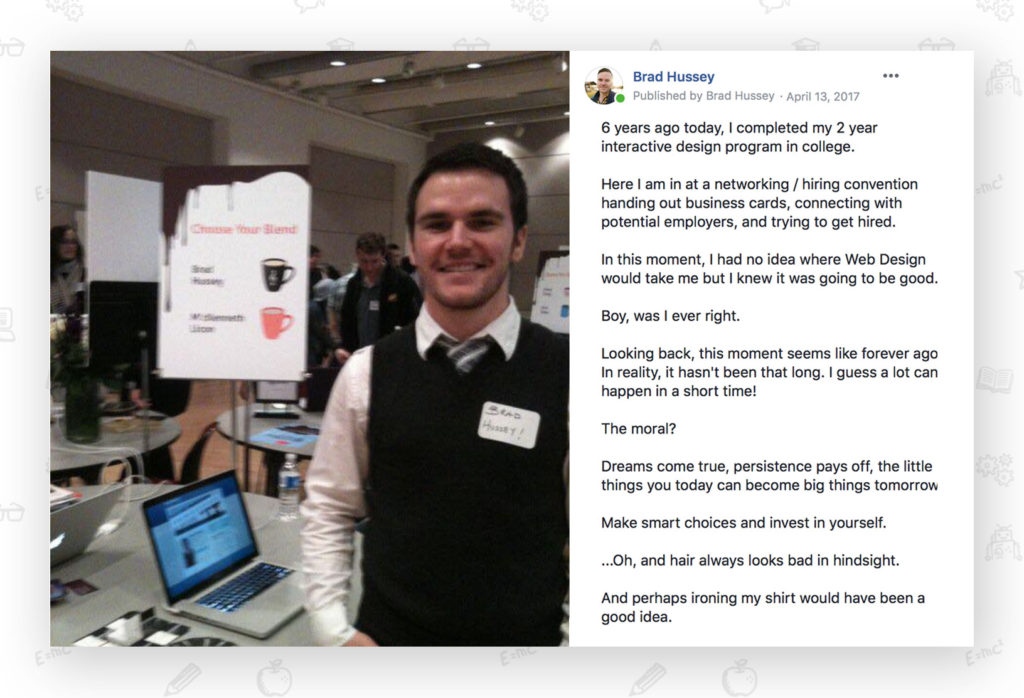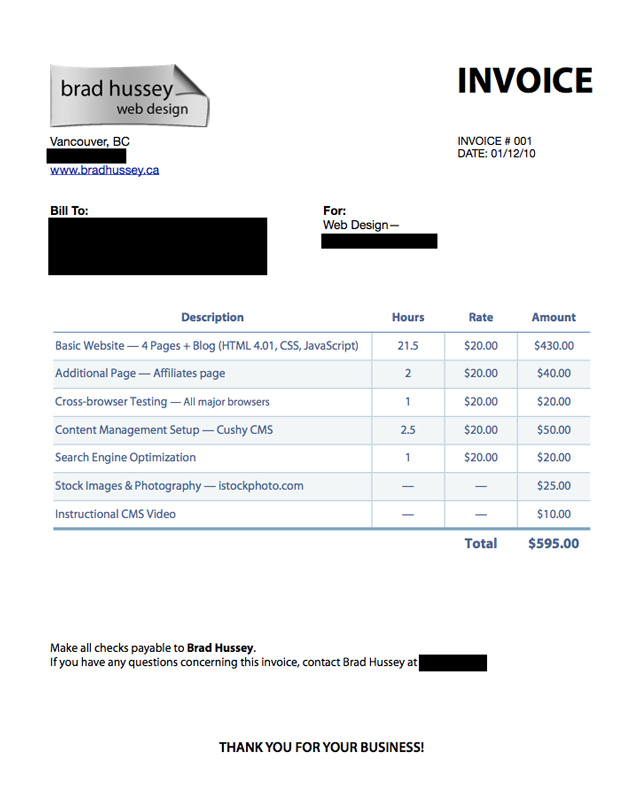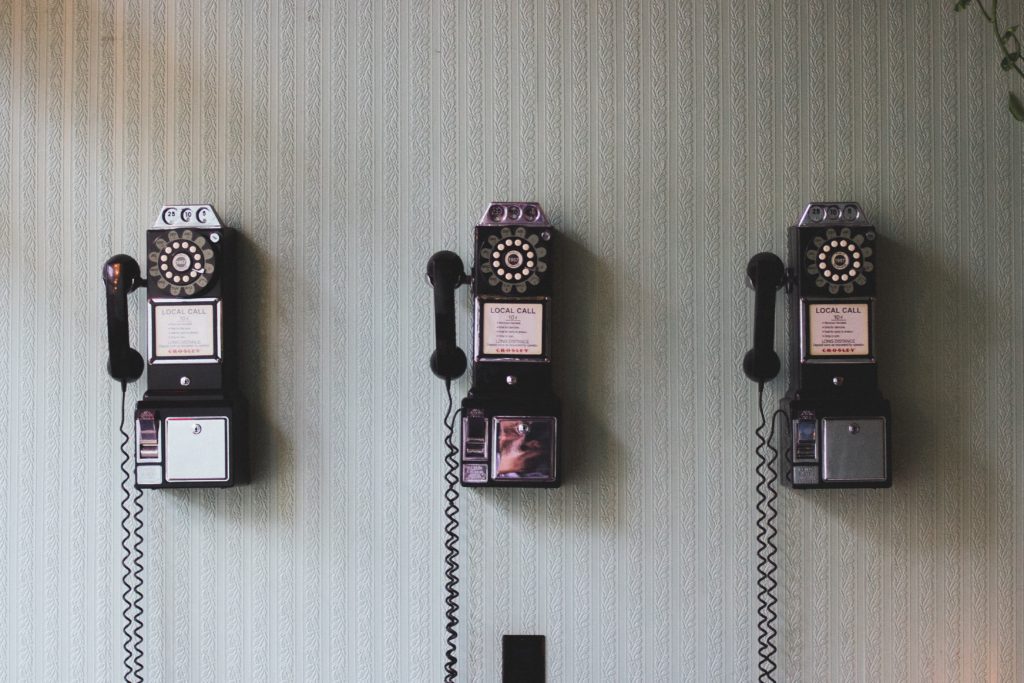Do you want to learn how to start a freelance business from scratch this year, book yourself solid with clients and be your own boss as a web designer, writer, coach or consultant?
If that sounds like you, you're in the right place. Read on!
I love it when I meet an aspiring freelancer! There's just something exciting about a person who isn't afraid to go against the common societal advice that says you should keep your head down and "get a real job"! I think it's nonsense; complete poppycock. I'm a huge advocate of self-sufficiency and independence. In fact, I recently came across a quote by the late, great G.K. Chesterton, and he says...
"The opposite of employment is not unemployment; it is independence!"
G.K. Chesterton
If you want to go your own way, create independence and freedom in your life, you need to start your own freelancing business! An employer will not provide you with the possibility of freedom, independence and impact that being an entrepreneur can. Don't get me wrong, we need employees! But if you're looking for advice to find a good job and be a great employee, I won't be able to help you.
But if you're a web designer, writer, developer or consultant and wish to start freelancing from home? I'm your guy.
The complete guide to starting your freelancing business in 2022 as a web designer, writer, coach or consultant
Even if you have no clients, no niche and no experience.
Fair warning: This complete guide to freelancing is gigantic and will take some serious time to read. To get the most from the course, I suggest signing up for the "email version" of the course, where I'll send you one lesson per day for 5 days. Plus, you'll also get an accompanying interactive workbook with each lesson to help you apply what you've learned.
Lesson Outline
Lesson 1 - Why do you want to start a freelance business?
Lesson 2 - The Formula for Finding a Profitable Freelance Niche
Lesson 3 - Book your first freelancing client
Lesson 4 - Price & position your freelance services like a pro
Lesson 5 - Deliver a successful project for a freelance client

Lesson #1
Why do you want to start a freelance business?
Before you embark on your journey towards planning, launching & growing your business, there is one very important thing you need to do...
Understand the motivations behind your desire to start a business as a freelance web designer, writer, or consultant.
Notice how I didn't lead with, "you need a business plan", or worse, "you need to spend tens of thousands of dollars on a business degree"?
Nope.
You need to define your "why".
Watch: "Building a Foundation for Your Freelance Business" on YouTube
At the very core of your being, the reason you get up in the morning, the thing that gives you purpose is your “why". Everyone has a why. You may already know exactly what your "why" is, or maybe you’re not sure and need some help digging it out. Even if you don’t know what it is, it is there.
As an employee, I spent more time with my boss than my wife, I had little independence from my employer and I was even chastised for going on a 2-week vacation. I couldn't expect my salary to grow very much throughout my career because I wasn't paid for my output or the value I contributed to the market.
My why can be summed up with 3 words:
- Family
- Freedom
- Finances
In that order. I'll expand on each of them.
Family - The reasons why I decided to start my own home-based freelance business is because I wanted my precious time on earth to be spent around my family — my wife, and my children — not in rush hour traffic, with my boss, or even co-workers. I also believe that, as a father, it is my responsibility to be a provider, to be a role model for my children, and to set a real-world example for others that independence and self-sufficiency is an incredibly rewarding and empowering path.
Freedom - For me, growing somebody else's business and helping them attain their vision by giving them 70 - 80% of my most valuable asset—my time—seemed like I was on the losing end of a bad deal. I'd like to avoid using the cliché that "I live life on my own terms" because, the reality is, life is unpredictable and nobody truly has control, but as for the things of which we do have control — where we spend our time, to whom we provide our services, how we provide for our families — it's important that those happen on our terms! Starting my own business has empowered me with the freedom to spend my time where it matters, work with the people I am passionate to serve, and even take a vacation when it works best for my family (not when my boss approves).
Finances - I have no ceiling on how much money I can earn as a freelancer. I'm rewarded for my output and the value I add to the marketplace. If I need to pay for a big expense, save for our children's education, create financial independence... I have the freedom to make that happen (so long as I work for it)!

Lesson #2
The Formula for Choosing a Profitable Freelance Niche
In this lesson, we're going to explore the strategy behind choosing a profitable plan for your freelance business.
Because after all, you're starting a business to:
- Solve a problem
- Profit from the solution
- Enjoy yourself while doing so
Right? (The answer to that is yes. Otherwise, it's not a business you're trying to start.)
Which means you need a good idea to run with!
So how do you choose an idea & know if it's profitable?
For a business to succeed, you need only three things:
- A problem to solve
- A solution to the problem
- A customer willing to pay for it
That's it. That's the magical formula behind every successful business. No exceptions.
With that in mind, we need to figure out how to apply that to our situation. And to achieve this, I like to use, what I call, the "Bull's Eye Test" to find out if an idea is worth pursuing. It looks like this...

The overlap between what you are good at doing, a problem for a specific group of people, and the solutions you can provide to them is called your niche.
Watch on YouTube: Find Your Freelance Niche
First, start with passions
List out everything you are passionate about & communities you are involved in. Let's go with...
PASSIONS
- Travel
- Family
- Small Business
- DIY Home
- Marketing
- Real estate
Second, identify market problems within your passions
Within those categories, list out the problems or pain points that you think people experience within it...
Passion #1: Family
PROBLEMS
- Help with meal planning
- How to "sleep train" a baby
- Homeschooling curriculum & best practices
- Teaching kids how to swim
- Childcare
PASSION #2: DIY Home
PROBLEMS
- How to repair/fix common household issues
- Renovations & home projects
- Plumbing, electrical, HVAC, etc.
- Lawn-care & landscaping
Passion #3: Small business
PROBLEMS
- Don’t know how to market effectively
- Setting up & growing an online presence
- Hiring, firing & employee management
- Money management, accounting & taxes
Finally, determine possible solutions
Hypothesize possible products & services for a market problem you are passionate about solving (or able to solve)...
Passion: Family
Problem: Childcare
SOLUTIONS
- Freelance babysitter
- Nanny agency
- Dayhome for Pre-K children
Passion: Small business
Problem: Creating a digital presence & finding customers online
SOLUTIONS
- Web design & branding consultancy
- Social media marketing software
- Live training events to teach marketing
Problem: Hiring, firing & employee management
SOLUTIONS
- Human Resources agency
- HR training courses, events & webinars
- Freelance HR consultant
Got it?
As you can see, there's a science behind landing on the "perfect" idea. Many aspiring business owners fail to do this exercise, and hinge their efforts on "hoping for the best" — I don't think that's a smart strategy.
Okay, so let's say you've drummed up a couple of promising ideas. What now? Do you just... launch?
No!
You need to validate your idea to know if your business plan is viable — meaning if people will actually pay you to solve their problem.
There are dozens of fancy techniques for validating your business ideas out there, but I'm a bit old-school, and I think we should cut straight to the chase and use the only validation technique that matters...
Cold hard cash. Will someone pay you actual money to solve the problem you said you would?
In other words, land a paying client.
In this lesson, we're going to jump in with two feet and see if we can validate our business idea with the best validator in the world...
Paying clients!
Lesson #3
Book Your First Paying Freelance Client
A common misconception amongst aspiring business owners, freelancers and consultants is that they believe they "don't have enough skills" or "experience" to start their business and that once they "learn more skills" or "get more experience" THEN they will be ready to launch. Don't believe this lie. These people continue to tell themselves these lies until it's too late, or they've lost all desire to start a business. It's a trap.
You're as ready today as you will be in two years from now.
There's a wise saying that goes, "if you wait for the perfect time to have children, you will never have children", and this saying works very well in business as well...
"If you wait for the perfect time to launch your business, you will never launch."
We'll always find an excuse because the timing will never be perfect.
Which means that right NOW is as good a time as any.
"But wait, Brad!" you might say, "I really don't think I have enough skills in my desired field to start my business!"
I don't buy it.

Back in 2009, I was two months into a design diploma in college, and I had 10 classes of HTML & CSS under my belt. Long story short, with barely any useful skills I landed my first $595 client and built a custom website for their new chiropractic business. And that was just the beginning.
The point is, if you have some basic level of skill in your desired field, you are good enough for now.
Just work on improving your skills, abilities and talents as you go! Learn by doing... "Theory" doesn't solve problems.

As you grow and become more skilled and experienced — so will the expectations (and budgets) of your client-base.
So stop making excuses. You have no time for them.
Another misconception is the belief that you need a website before launching.
Nope! Your clients don't care about your skills, your website, or your education.
Sorry to break it to you, but your clients don't really care about you, at all...
They care about having their problem solved.
So, stop thinking about yourself & worry about your client, instead. The better you can understand their pain point, the easier it will be to offer an irresistible solution. The more painful the problem... the more valuable your solution... the more profit you'll make. The better you serve your client, the more success you'll see.
Watch on YouTube: Where to find your first paid freelance clients
So, with that out of the way, let's get to work on booking your first client, ok?
Lesson 3 Workbook:
Generate a personalized script to post on social media
We're going to create a customized script on-the-fly that you can post on social media. Most of my students see results on Facebook, some have seen responses on LinkedIn and Instagram. You can also straight-up email 20 close friends, family & professional connections.
By the way, it's entirely possible that you won't get any bites on the first try — that's okay. Are we only allotted one chance to launch? No, that's another misconception. If it doesn't work, tweak the message & post it again a week later, or try a different platform, or message different people.

Lesson #4
Price & position your freelance services like a pro
Before we jump into today's lesson, I want to tell you a story about me in my early freelancing days...
Early in my freelancing career, I had the honour of working with the internationally renowned negotiation expert and bestselling author, Peter D. Johnston. And it was with Pete, as he liked to be called, that I learned one of my best lessons on pricing. When he asked me to send him a proposal to design and build two websites, you can imagine how nervous I was — man, this guy is gonna negotiate the heck out of me, and I’ll stand no chance to get paid what I’m worth!
So, I drafted up a proposal, came up with a price I was happy to charge, and sent it off to my client. Not long after, I got a phone call from Pete.
Uh oh.
“Hey Brad, how are you? Listen I got your proposal, and I had a couple of questions.”
“Hey Pete, thanks for getting in touch. Listen, I’m sorry if the price is too high, I just—"
Then he stopped me mid-sentence, and what he said, I’ll never forget.
“Brad. Don’t ever apologize for your price, to me or anyone else,” he continued, “I’m looking to you for help, and you deserve to be paid the price you ask.”
As our conversation came to a close, he accepted the proposal (with my original price), and then he said,
“Alright, Brad, what do I owe you for this phone call?”
“Sorry, pardon me?” I said.
“You just gave me 30 minutes of your time. Surely you could have been working on something else, and it’s unfair of me to expect free consultation from you. Send me your bill for the phone call, and any other phone call we have in the future.”
Watch on YouTube: Don't use these pricing strategies in your freelance business
We all struggle with pricing our services, asking money from other people, and we worry that we’re performing some sort of evil by sending an invoice. But if we’re always apologizing and feeling guilty about charging for our products & services, how much confidence do you think our customers and clients will have in us?
Remember that you are solving somebody’s problem and making their lives better in some way. The product or service you provide is valuable, and people expect to pay for it. You wouldn't expect a dentist, lawyer or your local farmer at a market to give you their goods & services for free, simply because they're self-conscious about asking for money - would you?
Of course not! So, in this lesson, we're going to learn about a pricing technique that will:
- Increase your revenue
- Improve your chances of booking a client
- Position you as an expert who knows what they're doing
I call it the "Triple Threat Technique".
Most freelance designers, writers, consultants & new business owners approach pricing in this way...

- A new lead comes your way
- They ask for a price
- You give them an offer
- They either accept, or they reject
And that's where it ends. What happens to the Lead who says "no"... well, they're gone. You took the possibility of a fruitful relationship with a client for years to come, and left it up to a 50/50 chance. Don't gamble with your clients.
Here's what you should be doing instead...

A prospective client contacts you and says...
“I need a website. I hear you’re the gal for the job. How much?”
You respond with...
“I’d like to first determine how we can best help you. Let’s jump on a call to discuss your project, your goals and how we can help you achieve them. In the meantime, please fill out my project planner, I’ll text you a link.”
Then, send a Productized Proposal
Outline the project scope, your understanding of their goals & desires, then provide 3 separate options, or "packages", with increasing levels of value within each.

PACKAGE A
$1,250
- Simple, standardized solution
- No extras or features
- Simple to produce with a quick turnaround
- A budget-friendly option
PACKAGE B
$2,000
- Some standardization, some customization
- Full solution with extra benefits
- Longer time & energy investment
- Attractive to clients who are looking for results over budgets
PACKAGE C
$3,500
- Premium, tailor-made solution
- Extra benefits & unrestricted value
- Clear & calculated ROI
- Attractive to clients who desire results and ROI
Clients love this because they feel in control of their investment, and they see you as a professional who is genuinely looking to help.
This is a winning strategy for both you and your clients or customers! When you force the clients to comply with your qualification process, only the qualified prospects will come out the other end, and when you take the time to understand the actual, underlying problem your client wants you to solve, you can show your client that you listened to them by presenting a compelling solution in your proposal.
Ultimately, once they pop the question, “What’s the price?”, your answer isn’t “take it or leave it,” rather your Packaged Solutions say, “That’s up to you!”
Try this out on your next web design, writing or freelance project!
Recommended Resource: Pricing Workshop for Freelancers
In this free workshop, sponsored by Chronos Time Tracking, you'll learn how to strategically price your services, maximize your profitability, and make your clients happier in the process!
Access the free workshop here.

Lesson #5
Successful project management for freelancers
Let me ask you this: which person will be easier to "book" for a project?
- A prospect who contacted you via an ad you put on Facebook
- A previous paying client who was happy with your services in the past
Your previous paying client, of course! Why is that? Because they already trust you, understand your value & you've served them in a productive and helpful way. The cold prospect? They're still in "shopping around" mode, therefore, they will be harder & more expensive to convert to a paying client.
Landing the client is just the beginning of a successful project & meaningful customer relationship for years to come. Many freelancers believe getting clients is the most important part... Nay! While it's crucial that you book clients, it's even more vital what you do after you've booked them.
Let's dive into each step of the project journey from beginning to end and beyond. Here's the action plan for delivering a successful project, and maintaining a valuable relationship with each and every customer after the project is completed.
Project Process #1
Qualify your prospects (and weed out the bad apples) with an Automated Project Planner

When you’re starting out as a freelancer, it's not uncommon to accept anything that comes your way — in fact, it’s what I recommend doing at first. You have to start somewhere. But as you gain experience, you’ll need to be a little more picky with who gets to work with you because not all clients are good clients.
Ever heard of the 80/20 rule (a.k.a. The Pareto Principle)? Well, it usually works out that 20% of your clients generate 80% of your income. These are higher quality clients, they pay more, have more interesting projects, and they’re easier to work with.
So, focus on attracting the high quality 20% by setting expectations, and giving a new prospect a few “hoops” to jump through.
If a client can’t make it through your project planner (which is essentially a questionnaire about their project requirements) they are displaying behaviour that might show up later in the relationship, and they likely aren’t a good match for you. Move on.
Oftentimes, at the very beginning of getting in touch with a prospect, there is a lot of wasted time going back and forth via email. The prospect has questions, you have questions, you both wait for one another to respond, and this can take the better part of a week — remember, all of this is unpaid, and you haven’t even signed them on as a client yet.
With every prospect, you’ll have the exact same handful of questions & requirements — What's your business? What's the problem? What's your budget? Timeline? etc. — if you don’t standardize this process, you’ll waste hours every single time a prospect lands in your inbox.
So, how do you standardize this process? Create an online "Project Planner" Form!
Using a free service like TypeForm (what I've been using for the workbooks in this course), create an online form with all of the information you need from a new client in order to understand who they are, their business, what they require, their goals, their budget & timeline, and any information you need from them.
You can check out my Project Planner I send to all of my prospective clients here — feel free to use it as inspiration, change things around, customize it to suit your business, and create your own Project Planner.
Your Project Planner will save you a ton of back & forth time with the client, it shows you’re professional, and it will give you all of the necessary information to decide if this is a project you can (or want to) take on. If they can’t provide the information you’re asking for, or take too long to fill it out, you’ve just filtered out a bad client (and you’ve wasted zero time on them).
Project Process #2
Schedule a Discovery Call

Let’s say the client filled out the form, everything looks good to you, and you’re interested in the job. The next step is to jump on a call with them to discuss the information they provided you, clarify any details, ask & answer some questions, and to make them aware of the next steps.
Scheduling a discovery call is usually a big time waster because there is often back & forth trying to arrange a good time that works for you both. I use a free service called Calendly to virtually eliminate this problem. You choose the times that work for you, send the link to your client, they get to pick the best time for them, your online calendars (Google, iCal, etc.) will be synced, and you’ll both be automatically notified of the appointment time. Done.
PRO AUTOMATION TIP
If you'd like to eliminate the manual process of sending the prospect a link to your Calendly scheduler, try this: after your prospect successfully fills out your Project Planner in TypeForm, on the "Thank You Page", provide a link to your Calendly scheduler and let your prospect know that they can book a convenient time to jump on an initial discovery call. Now, the Qualification and Project Planner processes are completely automated — all you have to do is show up to the call and close the prospect!
Project Process #3
Send a productized proposal

A proposal can be as simple as a PDF document or as fancy as a custom-designed experience on paper, but remember the point is to show the client you’re professional, understand what they need, and are proposing a solution to their problem. A proposal is a document that outlines:
Who you are - A brief professional bio. Think LinkedIn.
Your experience - Almost like a resume, but way more concise and specific to the project at hand. List 2 or 3 of your best pieces of work with some simple descriptions. If you have no experience yet, you may omit this, unless you have some impressive personal projects or endeavours.
Testimonials - Social proof, reviews and success stories are powerful trust-building tools! We all jump straight to the reviews of a product we wish to buy because we trust the word of other customers, so why wouldn't we offer the same experience to our prospective clients? Try and get testimonials as early as possible from clients & colleagues. List 2 or 3 testimonials from people you’ve worked with (tip: use LinkedIn’s recommendation feature with people you're connected with to get testimonials).
Client requirements - Write a brief summary of your understanding of what the client needs. Since they've filled out your project planner and you've had a discovery call, you should have valuable information to pull from in order to summarize their needs.
Your solution - Write a brief, human-readable summary of what you’re offering that will solve their problem. This isn’t the place for jargon and industry-specific lingo, rather, this section explains how you will solve the client's problem.
Project timeline -Break the project down into major milestones and outline the delivery dates for each milestone. Remember, projects often take longer than you think, and if you end up being 3 months overdue on your promised deadline, that's on you (even if it was the client who delayed the project). Finally, instead of using hard dates, like "August 10th", I suggest using a weekly timeline (i.e. 6 weeks, 10 weeks, etc), if applicable to your project, of course.
Packages - Based on the client’s specifications you got from the Project Planner and the Discovery Call, you should be able to accurately decide how much the project will cost. Whether you’re charging hourly, a fixed-fee, a weekly rate, or value-anchored pricing, this is where you’ll highlight your final price. As you learned in Lesson #4 of this course, you shouldn't just give the prospect a single price — you'll put the prospect on the defensive and force them to say "yes" or "no... most often with the client saying "no". Instead, you should split up your solution into "packages" — no less than 2, no more than 3 — so your client can choose which option works best for their business.
Payment schedule - Depending on the size of the project, you may want to split the price up into payments. Without exception, ask for a deposit up front! While you can reasonably assume that if your prospect made it through your qualification process (project planner & discovery call), they're probably not going to mess you over. That said, you can't be too careful and this is your last line of defence from a bad client! If they're not willing to pay a deposit, that's a huge red flag. Find out their reasoning, and explain why it's reasonable and important for you to collect a deposit. If they can't pay up, point them in a different direction and respectfully move on.
Terms & Conditions - This is where you’ll outline any necessary terms & conditions for the project. This will greatly depend on the nature of your business, and if you're unsure about what kind of terms & conditions you should outline, consult an attorney (or a lawyer buddy). A quick Google search should give you some templates to work with.
If the client likes your proposal and wants to move forward, make sure they sign the document! If they don't sign, you don't start. There are many free or affordable tools you can use to generate proposals and collect digital signatures, too — I suggest HelloBonsai.
I also highly recommend having your client sign an official contract. It's a more official legally binding document that covers your butt. There are many tools that will help you do this, but I suggest HelloBonsai.
Project Process #4
Collect a deposit payment before starting your freelance project

I don’t take risks with new clients (even some regular clients), so I always request a deposit upfront before I even start. I typically accept cheques, eTransfer, or credit card via Quickbooks.
There are some great tools that allow you to create estimates, invoices, and accept payments from clients. I highly recommend investing in one of these services, since manually keeping track of everything is not scalable, and a great way to forget about overdue invoices.
Here are some recommendations:
Project Process #5
Onboard your freelance clients using automation & systems

After you've collected your deposit and all the signatures you require — it's time to start! Now it's time to onboard your new client so they feel like they are now a part of a smooth, professional process. Even if you don't know what "onboarding" means, if you've ever had a client before, you've put them through an onboarding process — you just didn't know it, and if you didn't know it, you likely executed the process very poorly. I suggest providing your new client with a "Welcome Packet".
An effective (and impressive) Welcome Packet will:
- Welcome the client (with a note, written letter, or email)
- Tell them what to expect
- Outline a project schedule
- Outline your expectations of the client (i.e. what you need from them to keep on track)
- Provide homework to the client (i.e. assets, passwords, information, copy, etc.)
- Answer common questions clients have
- Give them instructions to access your Project Management Tool (i.e. Basecamp, Trello, Asana, Dubsado, etc.)
- Provide your contact information (and clear boundaries of your availability, i.e. Mon-Fri, 9 am - 5 pm)
- Anything else you would like to include
To reduce the repetition of this process for each new client, create a template Welcome Packet (i.e. PDF, email, handwritten letter, video, etc.) that you can use to efficiently create an onboarding process for each new client.
Project Process #6
Deliver the project beyond all expectations

This part is heavily dependant on you! You know the project, your client, their expectations, the timeline and your abilities. But my best word of advice is to maintain regular communication with the client (i.e. every Monday at 11 am you are required to have a 15 minute "weekly kick-off" call with the client), and do your absolute best to over-deliver on the project in less time than you'd promised. Your job is to serve the client, and serve them well... so well that you'll secure a customer for life.
Before handing over any final deliverables, get a "sign off" approval from your client and collect final payment! Far too many freelancers have handed over the keys before collecting payment, only to be left stranded with no cash and no... car? You know what I mean...
Project Process #7
Offboard your client & continue adding value

So, you've got your official sign off, collected payment, delivered the project, and everyone's happy! You're done, right?
If you're an everyday, average freelancer... sure. But you're not an everyday, average freelancer, are you?
That's what I thought. No project is ever done; there will always be improvements to be made, updates to be implemented, managed, and so on. If you finish your work and drop off the face of the planet, your client will find somebody else to hire for new work.
Offboarding is simply the process you execute once the project is complete. While most other freelancers drop off the face of the planet after completing a project for a client (and they end up wondering why it's so hard to grow their business), your job isn't finished once you wrap the project with your client! Remember how your onboarding process was fine-tuned & systemized with a "Welcome Packet"? You want to do the same thing for the offboarding process, but this time with an offboarding document — I've heard it called a "Goodbye Packet", but you can call it what you wish.
An effective (and impressive) offboarding document will include:
- A thank you note (i.e. handwritten, email, or video)
- A summary of the project and what you provided
- Instructions for managing their investment
- An offer for protecting, maintaining or growing their investment (i.e. a retainer package, product, additional service, etc.)
- An encouragement to refer you to their network (i.e. you could offer a referral reward, or simply ask if they spread the word about your business)
- Contact information to reach out to you for assistance & future work
- An invitation to follow you on Facebook, YouTube, LinkedIn (or whichever social media tool you use to provide value)
- Any other info you feel is necessary
But wait, there's more! It doesn't end with the offboarding document. At this point, your client will be very impressed by your care & professionalism, but you want to make sure that you are always on "top of mind" with your client, so I suggest adding them to your newsletter. I use ConvertKit for my email marketing engine and to deliver automated weekly newsletters, but there are other tools out there as well.
You could always just invite your client to like your social media page, and make sure you add value to your social audience on a regular basis — but you don't own that audience and the social media giants are known for pulling the rug out from people on a regular basis (this is called building a business on rented ground). With an email list, you are given explicit permission directly from the subscriber to communicate directly with them in their inbox — a much more valuable place to be.
As you continue adding free value to your previous clients, you'll be seen as the expert who has a "finger on the pulse" of the industry, and the trust you build in this stage will work in your favour when the client needs more help, has a new project, or requires their original investment to be "updated" or improved.
Now that you know how to start your freelance business, what's next?
You've come a long way! This has been a jam-packed post that I'm sure you're eager to implement in your new freelance business, so it's crucial that you strike while the iron is hot!
Now is the time to do something about your desire to take action on your business — not next week, not next month, not someday (which we all know means "never").
Before you get started on your journey, you can access this entire course in email format so you can keep the lessons close by when you're ready to put them into action.
If you loved this guide, found it valuable, or know somebody who would greatly benefit from reading it — please share it with them on Facebook, Twitter, LinkedIn or wherever they hang out 🙂
To getting booked solid!
- Brad Hussey

